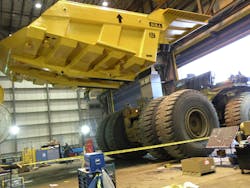Philippi-Hagenbuch HiVol Truck Bodies
Philippi-Hagenbuch HiVol Hard Rock / Ore Bodies are designed to handle highly abrasive material while minimizing carryback and maintenance requirements. Each body is customized to the individual mine’s specifications. The company’s proprietary Load Profiling process examines the natural angle of repose, or how the material lays once it is dumped into the body, to maximize its payload capacity and reduce potential for material to fall out of the body.
Patent-pending hydrophobic steel liners provide durability and ensure maximum dispersal of materials when dumping. They are used in the front corners and the front third of the body slope, along with a high-abrasion liner in the rear third of the floor. The body tapers from the front to the back, which also decreases wear and carryback potential on the body sides. This design allows the company to cut weight from the sides of the body and use the extra weight capacity to reinforce other areas of the truck body that generally receive the most wear.
Reinforced body side top rails are half sections of rounded pipe that tie the inside steel plate to the outside plate at the top and cover the gap between them. They provide added reinforcement to the sides of the truck body and eliminate the potential for material to build up within the sidewalls. In addition, steel bolsters that run from side to side under the body floor double the size of the “sweet spot,” the area that can handle the greatest material impact, within the center floor section. The patent pending bolster design runs through the frame rails, which run from front to back and tie the floor together more substantially than any other floor in the industry.
